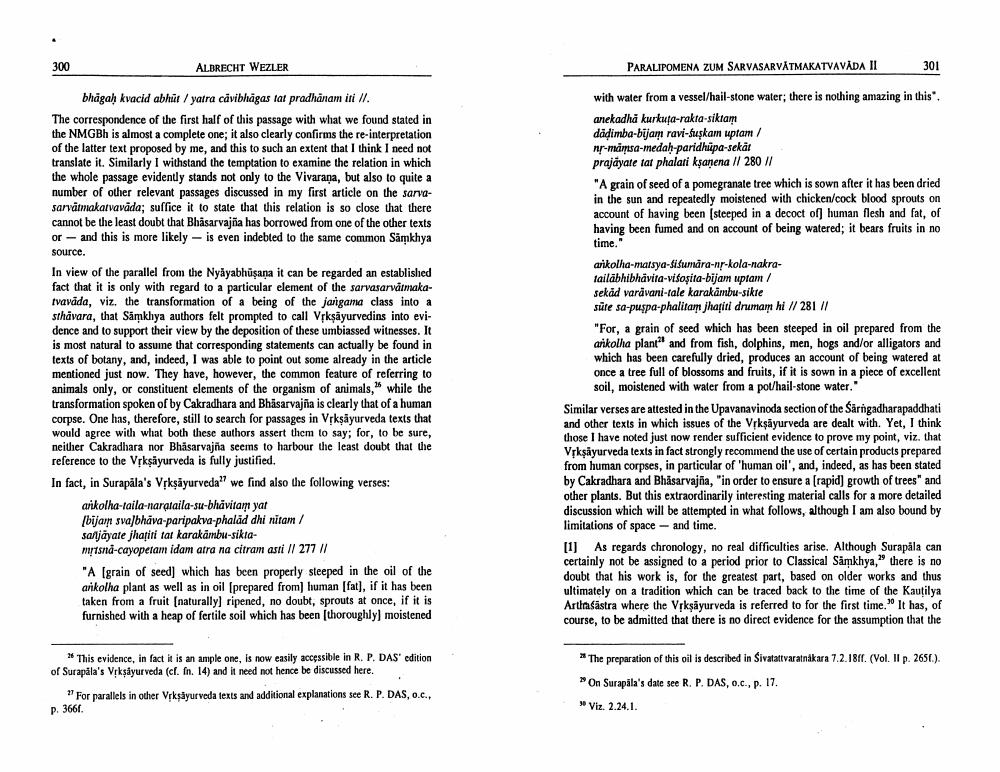Book Title: Paralipomena Zum Sarvasarvatmakatvada II Author(s): A Wezler Publisher: A Wezler View full book textPage 8
________________ ALBRECHT WEZLER PARALIPOMENA ZUM SARVASARVĀTMAKATVAVADA II 301 bhägah kvacid abhiut / yatra cāvibhāgas tat pradhānam iti II. The correspondence of the first half of this passage with what we found stated in the NMGBh is almost a complete one; it also clearly confirms the re-interpretation of the latter text proposed by me, and this to such an extent that I think I need not translate it. Similarly 1 withstand the temptation to examine the relation in which the whole passage evidently stands not only to the Vivarana, but also to quite a number of other relevant passages discussed in my first article on the sarvasarvatmakarvavada; suffice it to state that this relation is so close that there cannot be the least doubt that Bhāsarvajña has borrowed from one of the other texts or - and this is more likely - is even indebted to the same common Samkhya source. In view of the parallel from the Nyayabhūşana it can be regarded an established fact that it is only with regard to a particular element of the sarvasarvatmakatvavada, viz. the transformation of a being of the jaigama class into a sthāvara, that Samkhya authors felt prompted to call Vrksãyurvedins into evidence and to support their view by the deposition of these umbiassed witnesses. It is most natural to assuine that corresponding statements can actually be found in texts of botany, and, indeed, I was able to point out some already in the article mentioned just now. They have, however, the common feature of referring to animals only, or constituent elements of the organism of animals, while the transformation spoken ol by Cakradhara and Bhasarvajna is clearly that of a human corpse. One has, therefore, still to search for passages in Vrksãyurveda texts that would agree with what both these authors assert them to say: for, to be sure, neither Cakradhara nor Bhasarvajña seems to harbour the least doubt that the reference to the Vrksãyurveda is fully justified. In fact, in Surapala's Vrkṣāyurveda?? we find also the following verses: arkolha-taila-narataila-su-bhävitam yat [bija sva/bhava-paripakva-phalád dhi nitam / sajayate jhariti fat karakämbu-siktamitand-cayopetam idam atra na citram asıl // 277 II "A (grain of seed) which has been properly steeped in the oil of the arkolha plant as well as in oil (prepared from human [fat), if it has been taken from a fruit (naturally ripened, no doubt, sprouts at once, if it is furnished with a heap of fertile soil which has been thoroughly moistened with water from a vessel/hail-stone water, there is nothing amazing in this anekadha kurkufa-rakta-siktam dädimba-bija ravi-suskam uptam / nr-masa-medah-paridhüpa-sekat prajayate tat phalati kşanena // 280 // "A grain of seed of a pomegranate tree which is sown after it has been dried in the sun and repeatedly moistened with chicken/cock blood sprouts on account of having been (steeped in a decoct of human flesh and fat, of having been fumed and on account of being watered; it bears fruits in no time." arkolha-matsya-sifumāra-nr-kola-nakratailābhibhävita-visoșita-bijam uptam / sekád varāvani-tale karakāmbu-sikte sute sa-puspa-phalitam jhariti drumam hi // 281 // "For, a grain of seed which has been steeped in oil prepared from the arkolha plants and from fish, dolphins, men, hogs and/or alligators and which has been carefully dried, produces an account of being watered at once a tree full of blossoms and fruits, if it is sown in a piece of excellent soil, moistened with water from a pot/hail-stone water." Similar verses are attested in the Upavanavinoda section of the Sarngadharapaddhati and other texts in which issues of the Vpkṣāyurveda are dealt with. Yet, I think those I have noted just now render sufficient evidence to prove my point, viz. that Vrkṣāyurveda texts in fact strongly recommend the use of certain products prepared from human corpses, in particular of 'human oil', and, indeed, as has been stated by Cakradhara and Bhāsarvajña, "in order to ensure a (rapid) growth of trees" and other plants. But this extraordinarily interesting material calls for a more detailed discussion which will be attempted in what follows, although I am also bound by limitations of space - and time. [1] As regards chronology, no real difficulties arise. Although Surapala can certainly not be assigned to a period prior to Classical Samkhya," there is no doubt that his work is, for the greatest part, based on older works and thus ultimately on a tradition which can be traced back to the time of the Kautilya ArtinaSastra where the VỊkṣāyurveda is referred to for the first time. It has, of course, to be admitted that there is no direct evidence for the assumption that the *This evidence, in fact it is an ample one, is now easily accessible in R. P. DAS' edition of Surapala's Voksdyurveda (cl. fn. 14) and it need not hence be discussed here. *The preparation of this oil is described in Sivatattvaratnakar a 7.2.1811. (Vol. II p. 2650). On Surapāla's date see R. P. DAS, O.c., p. 17. Viz. 2.24.1. For parallels in der Vrksayurveda texts and additional explanations see R. P. DAS, O.C., p. 3667.Page Navigation
1 ... 6 7 8 9 10 11 12 13 14 15
